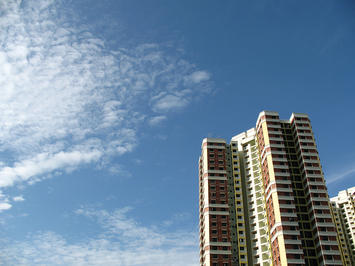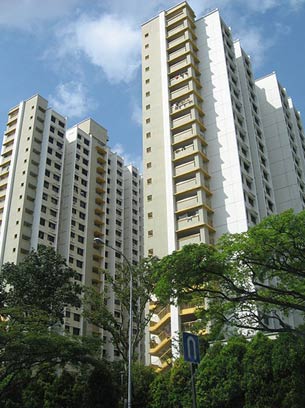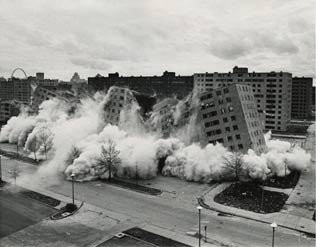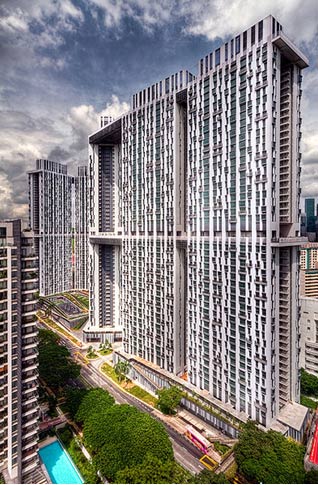
Imagine a future America where the home ownership rate climbs from the current 65%1 to 87%2. Libertarians as well as many social democrats would be cheering. Imagine that this rate was achieved by the state itself acting as the builder of 88%3 of the housing. Imagine also that the state imposes rules on home purchases to favor first time buyers and young families. “Progressives”, increasingly tilted towards the unmarried and childless, would bristile. Imagine racial diversity rules that restrict who you can sell your home to. Time for libertarians to shudder.
Most Americans would probably say such a concept is “Utopian” but serious policy makers should reflect that the word “Utopia” literally means “nowhere”. But Social Market Housing is alive and well in Singapore.
For Americans living in the hottest real estate markets, the USA is very far from the ideal of a Property Owning Democracy. At the time of the 2010 census three of New York City’s five boroughs had home ownership rates under 30% and in the Bronx it was under 20%4. Though many US politicians support the concept of home ownership it has been declining since 1980 when it reached a peak of 68%5.

How have the Singaporeans achieved such high ownership rates despite having the richest economy in South East Asia? Many factors come into play. Singapore has an aggressive building program achieved through a public body - the Housing Development Board (HDB). HDB apartments can only be sold to Singapore citizens and those with permanent resident status, so their prices cannot be inflated by foreign speculators.
The HDB also has eminent domain powers to claim land if it needs to. Singapore’s version of social security is not inter-generational (unlike the USA where the current generation of workers pays for the last generation of retirees) but rather an elaborate system of forced saving by both workers and their employers. Part of the compulsory savings can be used for a deposit on an HDB flat. Finally there is an elaborate system of price discounts on new HDB flats which is not only designed to favor first time buyers, but also young families and newlyweds.
There is even a category of ‘Executive Homes’ to retain managers in Singapore. These may be larger apartments or semi-detached homes with gardens.
There is no problem with runaway maintenance fees. HDB owners do not pay associations dues. Their elevators are maintained through local real estate taxes so monthly costs are very predictable. In the year 2010 the average Singaporean household paid $145 USD a month in property tax6
. This is less than the $216 average USD American Condo owners paid in condo fees at the time of the 2000 census.
Some Americans might argue that this can only work because Asians are conformist and are culturally more receptive to rule-based systems. I do find that South East Asians are reluctant to draw attention to themselves in public. When I talk in a Starbucks with my normal New York speaking voice I sometimes look up and find myself orating to a group of open-mouthed onlookers (“I’m so sorry it’s the Tourette’s Syndrome – my shrink keeps forgetting to up my dosage.”)
 Many US politicians recoil against the state as a real estate developer largely because tenanted housing projects have been such a magnet for social problems. The St. Louis public housing scheme, Pruitt-Igoe, was eventually dynamited (see photo right7). The author of “The Death and Life of Great American Cities”, Jane Jacobs, famously complained that the public housing projects took some mixed income neighborhoods which could have been viable and sealed their doom by concentrating too many low income and unemployed people in the same buildings.
Many US politicians recoil against the state as a real estate developer largely because tenanted housing projects have been such a magnet for social problems. The St. Louis public housing scheme, Pruitt-Igoe, was eventually dynamited (see photo right7). The author of “The Death and Life of Great American Cities”, Jane Jacobs, famously complained that the public housing projects took some mixed income neighborhoods which could have been viable and sealed their doom by concentrating too many low income and unemployed people in the same buildings.
Singapore’s HDB does act as a direct landlord for a very small number of people who meet a strict income ceiling (about $1160 USD a month8), however the low income tenants are spread thinly among owner occupiers. Income ghettoization is limited. My realtor tells me that one of the blocks in my own HDB estate is for tenants rather than owners but from the outside I cannot tell which building it is. Another form of deliberate social mixing takes the form of racial quotas intended to prevent the formation of ethnic enclaves. If the percentage of people in a given racial group has already met the national quota you can be blocked from selling or renting to a person in that category. Access to the more attractive and less attractive neighborhoods is thus shared out more equally. This looks like a policy American cities should consider given that the 14th amendment, busing and affirmative action have yet to produce full integration.
One aspect of America’s public housing projects that particularly angered Jane Jacobs was the wholesale removal of small retailers. In theory “The Projects” could have included small commercial spaces at the ground floor but generally public rental buildings in most of the US are considered to be danger zones where retailers fear to tread.
Typically the ground floor of HDB buildings is a void space where retailers can create businesses. Often they are left empty but sometimes the policy works well. Near Singapore’s Clementi MRT train station many dozens of “mom and pop” stores are now sheltering under the HDB apartments; late night street life is vibrant. When I ask Singaporeans to name a neighborhood that would be dangerous to go at night, nobody can think of one. The country’s homicide rate would pose an absolute disaster for TV script writers. You could not have a CSI series or Law and Order because Singapore would not be able to supply the requirement of one murder per week. The homicide rate is currently about one tenth of the USA’s9.

If she were alive today Jacobs might also criticize the HDB apartment blocks for excessive architectural uniformity. She loved communities to have buildings with different age profiles. But most of Singapore’s buildings are so new the option of preserving the old simply does not exist. Greater architectural variety is an attractive goal. One Singaporean architect commented that they will really have the styles right with you can build an HDB block next to a private condominium and you cannot tell which is which (a sort of urban planning version of the Turing Test). Local architects are point to a new HDB building, the Pinnacle at Duxton, as an example of a new look more comparable with private designs (pictured right).
But would greater variety cause costs to escalate? Observing new HDB construction it is possible to discern a very advanced form of modular building; entire concrete rooms are hoisted into the air at the end of a crane. Certainly a wider range of designs could be achieved using the same building blocks. Kids can make a huge variety of things with Lego. The same cuboids could also make homes with gardens which are America’s preferred form of housing--- a gift of an expansiveness impossible to achieve, except in dreams or by immigration, in Singapore.
Is Social Market Housing a good model for the USA? Certainly there would be many objections but the ideal of home ownership is too often an American Dream that disappears into a distant future. Are we doing enough to create a Commonwealth with “Liberty and Justice for All?” When they say the Pledge of Allegiance we force or children to use the words “Indivisible” and “One Nation”. Are we enough to make those words a reality?
Philip Truscott is a Senior Lecturer at Singapore University of Technology and Design
Notes:
Lead photo of HDB flats courtesy of BigStockPhoto.com. Other photo image files from http://commons.wikimedia.org
---------------------------------
2 SINGSTAT, (2011), “Statistics Singapore: Key Annual Indicators”, Singapore: Department of Statistics. Accessed on 19/11/2011 from <http://www.singstat.gov.sg/stats/keyind.html#hhld>.
3 SINGSTAT, (2008), “Key Indicators of Residential Households”, Singapore: Department of Statistics, Accessed on 19/11/2011 from <http://www.singstat.gov.sg/stats/themes/people/hhldindicators.pdf>.
4 US Census Bureau, (2011), “Housing Characteristics: 2010”, Washington DC: Bureau of the Census. Accessed on 19/11/2011 from <http://www.census.gov/prod/cen2010/briefs/c2010br-07.pdf>
5 This is based on a cross-tabulation of the variables “ownership” and “year” from the IPUMS online data analysis system at this URL http://sda.usa.ipums.org/cgi-bin/sdaweb/hsda?harcsda+1850-2009
6 Singapore Gross Property Tax Revenue from SINGSTAT, “Public Finance” at http://www.singstat.gov.sg/pubn/reference/yos11/statsT-publicfinance.pdf The number of resident households has been taken from the Census of Population 2010 at <http://www.singstat.gov.sg/pubn/popn/c2010sr2/t20-25.pdf>
7 Photo public domain: http://commons.wikimedia.org/wiki/File:Pruitt-Igoe-collapses.jpg
8 HDB, (2011), “Homes for All”, Singapore: Housing Development Board. Accessed on 19/11/2011 from < http://www.hdb.gov.sg/fi10/fi10221p.nsf/Attachment/AR0405/$file/home5_frameset.html>.
9 UNODC, (2011), “Homicide level for 2010, or latest available year”, Vienna: UN Office on Drugs and Crime, accessed on 17/11/2011 from < www.unodc.org/documents/data-and-analysis/statistics/Homicide/Homicide_level.xlsx >.













perversion
You can not have liberty for all and have the sort of gov't. programs you talk about. It'd be like trying to have a monogamous marriage and a concubine. You can't have the monogamy no matter what you call the 2nd partner.
Nightmare?
I lived in Singapore in the early 1970s, when a lot of these housing developments were being built and citizens were being moved into them, some say forcibly, from traditional dwellings. My recollection, albeit fuzzy, is that one of the big news stories the government didn't really want reported was the unusually high suicide rate among new residents, evidently not able to adapt to high-rise living and without alternatives. There is research on both sides of this issue; I encourage you to hunt it down and include it in this overview.